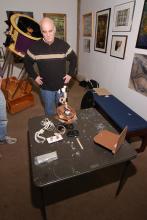Two page historical analysis of roadway glare sharply criticizing New Jersey. A much shorter version was printed on the Opinion Page of the Asbury Park Press on 3/8/05 titled "Lights avoid road glare".
VISION & MEDICAL CONCERNS CAUSED BY ROADWAY LIGHTING GLARE IN NEW JERSEY
New Jersey continues to install glary (non-cutoff) lights along its roadways, instead of only shielded (cutoff) lighting that would minimize glare and improve visibility. The drop globe lens of these non-cutoff luminaires appear as bright blobs of glare at night. Some of the lights are tilted upward spilling the glare even further. Such inappropriate lighting causes discomfort at the least, and sometimes even makes it difficult to see the roadway, especially for seniors. This is why most States no longer install such lighting. Cutoff lights have basically flat lenses to minimize glare and confine the light to the roadway, instead of shining it in our eyes as we drive.
In Texas, when George W. Bush was Governor, Dr. Louis S. Binder, OD, gave testimony about glare and night vision to the House State Affairs Committee. He fully supported HB916, regulating roadway lighting to require that only cutoff lighting be utilized, because it will make Texas roadways safer. Dr. Binder said: "A poorly-aimed, bright light can cause glare-related problems well beyond the light's effective illumination distance. Even after the light has passed out of the field of vision, the effects of glare persist. The human eye tries to adapt to the new brighter illumination, then must re-adapt to the normal dark conditions. During this adaption and re-adaption period, one's ability to see objects or edges of the road is impaired. Glare can also cause discomfort or annoyance, without necessarily interfering with visual performance. As one drives along the highway, the glare from a continuous string of lights can strain or fatigue the eyes that are constantly adjusting to lighting conditions." Then-Governor Bush signed this bill into law, which included lighting for all State funded facilities as well.
Professor Merrel Allen of Indiana University's School of Optometry, said a bright light source causes the human eye not to see closer objects that are well lit - causing the silhouette effect. "It makes those objects more hazardous to you because they are harder to see", said Allen. He also said that an early study done by General Electric in the 1950s on street lights proved that light had to be controlled to shine down to help motorist's vision. If the light were allowed to shine into the motorists's eyes, it actually reduced vision and increased the likelihood of accidents.
In 1998, The Massachusetts Medical Society passed a Resolution in support of a House Bill to control light pollution, that included the following statement: "Whereas, Glare by poor lighting is a serious safety issue in blinding drivers, making our roads unsafe, and is especially a problem for our senior patients with cataracts limiting their mobility at night due to the glare."
The Illuminating Engineering Society of North America, in its current Roadway Lighting Practice RP-8-00, makes it clear that "...non-cutoff luminaires should not be used for new roadway lighting. Non-cutoff luminaires inappropriately used may be considered a waste of energy." The Society also states: "Discomfort glare produces a sensation of ocular discomfort, which in its milder form, often causes an increase in the blink rate of an individual and, in its extreme form, causes tears and pain. While discomfort glare does not reduce the ability to see an object as in the case of disability glare, it may cause fatigue, which results in driver error." All unnecessary glare should be avoided. A younger drivers discomfort glare can sometimes be an older drivers disability glare, with acceptable, but less than perfect vision.
In 1993, at the request of anti-light pollution activists, the NJDOT conducted a study that concluded "...the Department can successfully adopt a program to introduce cutoff luminaires in high mast and conventional lighting. This will reduce light pollution to a great extent."
In 1996, The New Jersey Light Pollution Study Commission determined that Light Pollution was misdirected or excessive outdoor lighting that causes glare, light trespass (nuisance light), energy waste and unnecessary sky glow. The NJDOT's represented member on the Commission presented the chairman with a copy of a new "NJDOT Lighting Design Policy". Cutoff luminaires were to be considered first for almost all roadway lighting. This design policy has since been watered-down, providing loopholes that allow far too many glary non-cutoff lights to be installed. Why has the NJDOT been dragging their feet since 1996, and not until recently, begin to install only some cutoff lighting. Sadly, they still continue to use many glary non-cutoff lights along state highway intersections and elsewhere. When properly installed, cutoff lighting costs about the same or even less that non-cutoff. However, with the glare from non-cutoff luminaires, roadways can actually appear dimmer because of the "blobs" of glare in our field of view. So New Jersey is wasting energy producing light that we are unable to fully "see" and use. All freeway, highway and street lighting should utilize cutoff lights that will minimize glare. Then New Jersey can catch up to the many States that have made great progress in improving roadway visibility, by providing the public with the safest and best lighting possible.
By John Batinsey Revised December, 2004
Mr. Batinsey is currently a member of the Eatontown Environmental Commission. He was a member of the NJ Light Pollution Study Commission and served as Chairman. This State Commission submitted its report to the Governor and Legislature in April, 1996.
Section:

